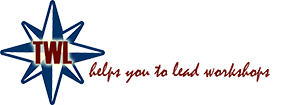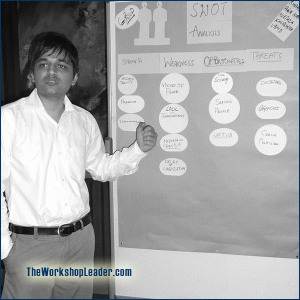We cannot solve our problems with the same thinking we used when we created them.
Albert Einstein (1879—1955)
German theoretical physicist
Like the Six Thinking Hats, SWOT is primarily an analytical tool. Nonetheless, you could also use it as a moderation technique during workshops to examine an idea with the input of the participants and make them acquainted with the core elements of a concept — let’s say, for example, your work on federalism.
SWOT stands for Strengths, Weaknesses, Opportunities and Threats. Mainly, you refer to internal factors, i.e. your organisation’s strength and weakness plus the opportunities and threats for you. For external analysis you would rather utilise a TOWS matrix which is quite similar but with emphasis on the environment.
You could give each of the items to one group. Either you let them only collect the respective elements or they continue with the second stage, the analysis. Often you’ll have a better outcome if you carry out the analysis with the whole group when the single teams come back.
Step 1: Set up an overall topic or question. For example: Will high quality publications gain the attention of our audience?
For collecting the elements help your participants with some leading questions (please refer to our template in the Annex — this can be photocopied and distributed). The more precise the answers are the better the results of the analysis will be.
Step 2: With answers to the questions — what are our strengths and weaknesses; what are the opportunities we can embrace; and what are the threats to tackle — fill in the table, covering each of these areas. This will provide a useful set of priorities for discussion of the most significant factors affecting your organisation.
| Strengths | Weaknesses | |
| Opportunities | Strengths vs. Opportunities With our knowledge we can produce publications before the annual budget is decided upon. | Weaknesses vs. Opportunities We lack good designers to come up with an attractive publication in time. |
| Threats | Strengths vs. Threats Our competitors come up with low-quality products which are distribute earlier than ours and more widely. | Weaknesses vs. Threats Design and printing might be too late compared with our competitors. |
In order to formulate a strategy or a plan from this table it is useful to match and convert. This means:
- Match: Strengths with Opportunities
- Convert: Weaknesses into Strengths
Don’t forget that every perceived threat is an opportunity for change and can be turned into an advantage.
From our example the reaction or plan can be: We will find an excellent designer and printer who will turn our ideas into a highly attractive publication in good time.
Check also these out:
[child_pages siblings=”true” link_titles=”true” title_link_class=”my_title_link_class” truncate_excerpt=”false” words=”20″ class=”myclass”]

